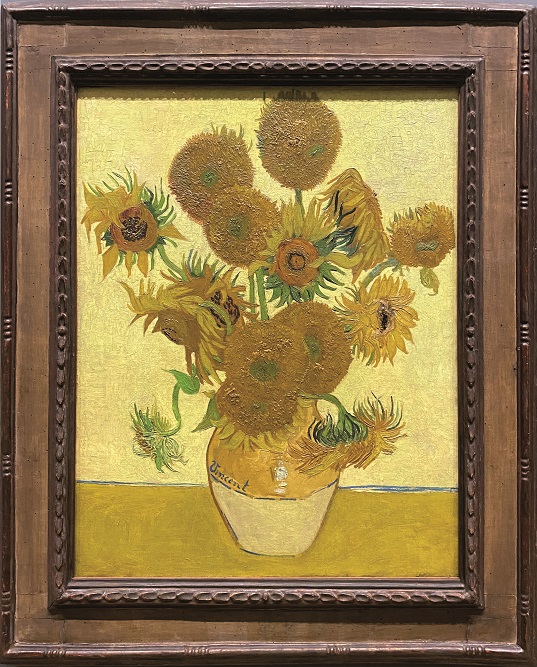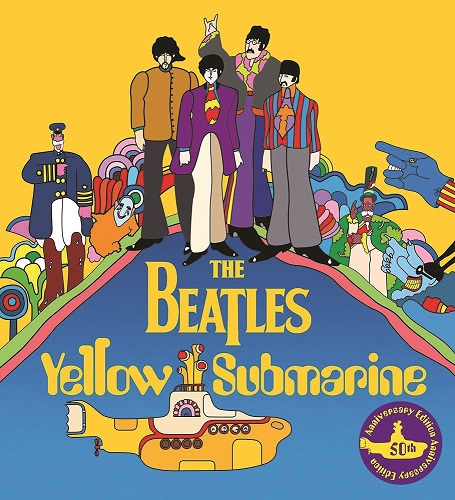A brief analysis of the history of a colour with many ambiguous characteristics: yellow. With its shades shifting from gold to amber to darker tones, its applications range from art history to television and music.
In children’s drawings, the colours of the world are perfectly defined and unambiguous: the sun is yellow and the sky is blue, its complementary colour. Once we are adults, however, we find out that the sun is white (although to be fair, this has been the subject of a long-standing controversy) and that it appears yellow to our eyes due to the passage of its rays through the Earth’s atmosphere, whereas the sky looks blue due to light coming into contact with gases in the air.
Yellow is the brightest of all the colours in the spectrum and the one that catches the eye the most. In nature, it is the colour of sunflowers, egg yolks, lemons, honey, and gold. In the man-made world, it is the colour preceding the stop signal in traffic lights, of direction indicators in cars, and of warning signs in general (road signs, soccer yellow cards, or post-its for example). It is associated with joy and optimism, enlightenment, curiosity, creativity, and lightness. However, as already seen in this column with several other colours, it also has its dark side: it is the symbol of cowardice, betrayal and jealousy, selfishness and madness. It is also the tint of caution and physical illness (jaundice, malaria, plague).
It is an ambiguous colour also in terms of nuances: the bright and intense yellow stands for positivity, whereas the more muted, “shadowy” yellow conjures up negative feelings. Indeed, famous colour historian Michel Pastoureau stated in his book dedicated to yellow: “Yellow is a gay, soft and joyous colour, but in poor light it quickly becomes unpleasant, and the slightest mixing makes it dirty, ugly, and uninteresting.” Yellow and its different shades, including gold, have been facing ups and downs in Western history. Let us look at some examples.
The origin of the word “yellow”
The term “yellow” (in Italian giallo, in French jaune, in Spanish amarillo, in Portuguese amarelo, and in German Gelb) derived from the Proto-Germanic gewalz, which indicated both “yellow” and “pale green”, as we already mentioned in our article devoted to green. Hence the Latin terms galbus (“pale green”) and galbinus (“yellow”) – which gave rise to jalne in ancient French, the direct progenitor of the Italian term giallo – but also the Old English word gelou – from which Middle English yelou and modern English yellow
derived. A curiosity related to the etymology of this word is the fact that the Indo-European root ghel, which means “bright”, “shining”, to which the origin of the term can be traced back, also means “to scream”, “to shout” – in other words, “to yell”, which is clearly reminiscent of “yellow”. Another confirmation that this vibrant colour is capable of attracting attention… starting from its very name.
Yellow in history
In his already-mentioned pages devoted to yellow, Pastoureau described the uses and meanings of this particular colour tone. Precisely because it is so closely related to the elements in nature, yellow is thought to be one of the first colours used by humans. In prehistoric cave paintings, it was often used to represent the sun and other luminous objects. The first evidence of the use of yellow pigments derived from ochre-rich clay soils dates back to 45,000 BC for the decoration of human bodies and cave walls. In ancient Egypt, the bodies of the gods were painted a vivid yellow to recall the gold associated with the sun. The ancient Greeks utilised it in wall frescoes. The Romans used it to decorate garments for ceremonies and weddings. The yellow tint for fabrics or artistic works was obtained from plants and sulphides, which contain sulphur that can sometimes cause mental disorders: this is why it was considered a diabolical colour, a prelude to the negative meaning that it would have gone on to take on in the Middle Ages.
In this historical phase, it became the colour of envy, jealousy, lies, dishonour, and betrayal, linked to falsehood, ambiguity, and untrustworthiness. These ideas were reinforced by the medicine of the time, according to which yellow bile was associated with a choleric temperament, considered violent, unstable, resentful, and hypocritical. Yellow thus became the colour of deception and began to be associated with those on the margins of society, from Judas Iscariot, who often wore a yellow robe in artwork, to the excluded and condemned, such as the Jews. From the 13th century, the Councils required Jews to wear a symbol of recognition: a yellow or red star that evoked the East – a sad custom resumed between the 1930s and 1940s, when the Star of David, often yellow, was imposed by the Nazis on all the Jews over the age of 6 residing in Germany and the occupied territories to make them easily identifiable and, therefore, prosecutable.
In Central European countries, asylums were painted yellow and prostitutes wore yellow garments to draw attention in the streetlight. This once again confirmed it as the colour that stands out the most. Some of the most particular chromatic choices with yellow as their protagonist have originated precisely from this aspect, including for instance the reflective “yellow vests” chosen as a symbol of the protest movement that shook France at the end of 2018 and that took its name from them.
Gold and yellow in art history
While it is true that this colour was sacred to the Egyptians and other peoples such as the Babylonians because it recalled the energy and power of the sun, its golden hue has been the protagonist of many works of art even later in history, from Ancient Greece to the present day. In ancient Greece, gold leaf was used mainly for the decoration of statues, the most famous of which were the chryselephantine sculptures (from Greek chrysós, “made of gold”, and élephas, “made of ivory”), of which Phidias was the best-known artist: the naked parts of the statues, such as arms, faces, and legs, were made of ivory, whereas their clothes, armours, hair, and accessories were covered with gold leaf. Beginning in 400 AD, illuminated manuscripts became widespread in Constantinople, Ireland, and Italy, with initials, borders, and miniatures made of gold or silver leaf. In the Middle Ages, gold leaf became a symbol of Christian art: in the sacred paintings of the time, the sky was made with gold leaf according to what was known as the “gold ground” technique, which saw its greatest diffusion around 1300 first in Italy and later in other European countries.
In modern times, gold leaf has continued to be used by many artists for the decoration of various paintings and works of art. The most famous of them is undoubtedly Gustav Klimt: during his so-called “golden phase”, he created a series of works with gold leaf that brought him to the pinnacle of success. On the other hand, Van Gogh, struck by the abundance of this colour in the southern French landscape, made extensive use of a certainly less “lavish” yellow hue. In March 1888, when he first arrived in the region, he wrote to his brother Théo: “The sun dazzles me and goes to my head, a sun, a light that I can only call yellow, sulphur-yellow, lemon yellow, golden yellow. How lovely yellow is!” He was so impressed that he decided to reproduce it in many of his works, including the famous “Sunflowers”. Unfortunately, in the paintings of this series, the paint is now inexorably turning brown due to the slow decay of the film caused by the use of the chrome yellow pigment (lead chromate), which darkens over time due to oxidation. Again, therefore, yellow is associated with decadence, death, or disease. Nowadays, yellow and gold continue to be used in art, especially in sculpture, cosmetics, painting, and fashion – with the most diverse meanings.

Fun facts about yellow
In 1929, Italian publishing house Mondadori chose yellow as the colour for the covers of its new series of detective books, emphasising the negative connotation of deception, treachery, and betrayal at the heart of this specific literary genre – so much so that “crime novel” translates in Italian as libro giallo, “yellow book”. In French culture, the saying “show someone that they have a yellow beak” is used to mean that a person is mistaken or inexperienced: this linguistic expression derives from the yellow beaks of young hawks, which do not know how to hunt, yet. In France, yellow is also the symbol colour of the Tour de France winner’s jersey, introduced in 1919 on the initiative of Henri Desgrange, a journalist from L'Auto (now L'Équipe): the colour was chosen in honour of this newspaper, which was indeed printed on yellow paper. Before the yellow jersey, the race leader wore a green armband, which was however often difficult to detect.
In the United States, the term “yellow journalism” refers to sensationalist tabloid journalism, which enjoyed great success in the late 19th century. The “Yellow Pages”, the telephone directories of companies known throughout the world before the spread of the internet, were created in 1883, when a printer from Cheyenne (Wyoming, USA), who was printing a normal telephone directory, ran out of white paper and used some yellow one. Yellow thus became the colour of business directories as opposed to the “white pages” of residential directories.
Yellow in music and play
Today, yellow is still a protagonist on TV, in games, and in music. In the former case, it is often chosen for its ability to attract attention; indeed, this is why Matt Groening, the creator of the famous cartoon series “The Simpsons”, allegedly chose it for his characters. In the history of music, yellow has often been linked to ambiguity, from “Yellow Submarine”, included in the LP record “Revolver” released by the Beatles in August 1966, up
to “Yellow” by Coldplay (2000), with which Chris Martin’s band became known throughout the world. As for the former, in the intentions of the Liverpool quartet, this catchy-sounding song was supposed to be a children’s tale, understandable to anyone, but fans saw underlying references to drug use: legend has it that Yellow Submarine was the name of a popular type of amphetamine at the time. In the case of the latter, which according to Martin was a love song written as an act of devotion to a loved one, many saw a reference to the illness or, more likely, anorexia of the woman to whom the song is dedicated.

Yet another reference to the double-sidedness of this colour can be found in the world-famous LEGO minifigures, first created in 197. Yellow was chosen to promote the idea of racial neutrality but, over time, it emerged that whereas white ethnic populations easily identified with yellow minifigures, the same could not be said for dark-skinned people. Starting in 2003, therefore, the Danish manufacturer began to introduce minifigures inspired by reality (NBA basketball stars) or movies (Star Wars or Jurassic Park, for example) with more realistic skin colouring.
Once again, yellow proves to be an equivocal colour full of different and opposing meanings. Perhaps, we ought better go back to our childhood and simply identify it with sunshine and joy, or build LEGO environments with yellow minifigures without seeing any negative reference in them, but rather with the lightness conveyed by this tint in its most positive sense.